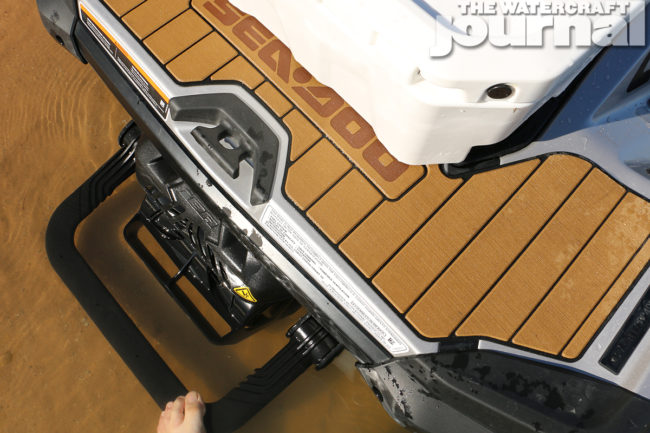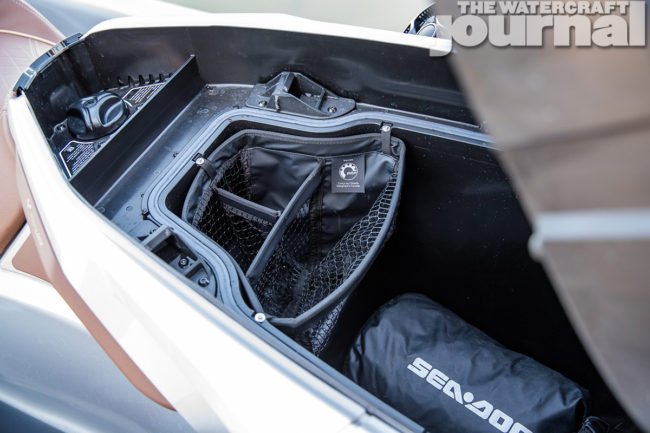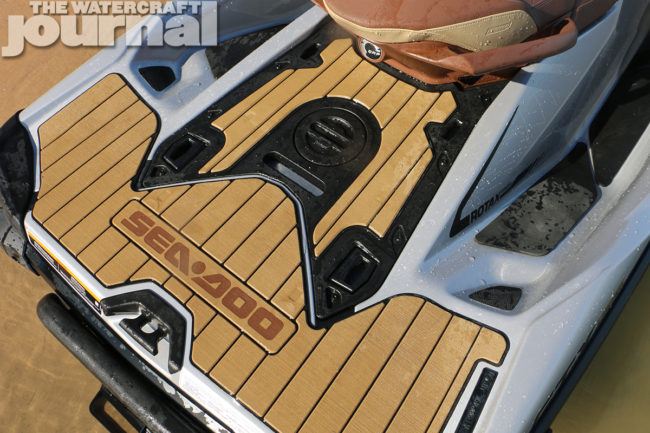
“Just look at that rich Corinthian leather!” I joked in my smarmiest Ricardo Montalbán impersonation, running my hand over the chocolate brown faux leather seats. The accent garnered a few laughs from the Sea-Doo staff as they doled out lifevests, sunscreen and snacks to those present at the media introduction of the 2018 Sea-Doo lineup. Leaning heavily on the livery cues of luxury automobiles, Sea-Doo made the best out of the new ST³ hull’s use of its proprietary CM-Tech molding process, and painted the GTX Limited 230 and 300 units in Liquid Grey Metallic to go with its Equestrian Brown seating. Certainly, brown is not the first hue to come to mind for a supercharged watercraft, but the cross-hatched printing and tan piping, paired with surprisingly convincing false teak-appearing traction mats on the expansive 366-square-inch rear platform, pushes the GTX Limited deeper into personal yacht territory.
In fact, the adorning styling cues throughout the new GTX Limited 230 and 300 units are impressive. The various body panels left in natural plastic on other units are painted, giving the GTX Limiteds a more angular but streamlined look. In fact, natural plastic is kept at a minimum. Accentuating certain key body lines are narrow, smartly formed threads of chrome – highlighting the “open buttress” steering neck and pseudo grille nose piece are two of the better examples. Gone is the complex “Transformer” aesthetic of the outgoing S³ platform, again giving the new ST³ a whole new curb appeal. Features like rope cleats are now smoothly integrated into the deck itself, both forward of the footwells and a center cleat at the transom.

In person, the machine looks low, and it is. Both driver and rider positions have been lowered 1.2-inches and 3-inches respectively. The footwells are also deeper and significantly wider, allowing a rider to easily swivel their foot around without discomfort (unless of course, you’re Shaquille O’Neal). The seat itself has been broken up into three pieces: the once one-piece bench is no longer hinged to the deck with a gas strut. Rather, the rear passenger seat separates with the push of two tabs at the base. The driver’s bucket seat is also quickly removed, revealing a small access portal permitting basic maintenance and fluid checks. The forward wings of the Ergolock seat are now padded coves smartly integrated into the top deck itself.
As with all ST³-based Sea-Doos for 2018, 13 torx-head screws hold down a nearly 4-foot-long access panel that when removed, reveals almost the entirety of the engine compartment. Access to the 1,494cc or 1,630cc four-stroke 3-cylinder (depending on whether you choose the 230 or 300-horsepower model), the supercharger, intercooler and exhaust arrangement is unparalleled. Improvements made to the powertrain aren’t noticeable but palpable: a simplified CLCS (Closed Loop Cooling System), a more thermally-efficient ride plate, a larger oil cooler, and a sacrificial anode in the intercooler are all new for 2018. For the 300-horsepower GTX Limited, the strongest performance gains were seen not in top speed (USCG caps it off at 68mph, we saw a bit higher), but in mid-range 30-to-60mph times, with the new GTX Limited 300 shaving off half a second (2.5-seconds vs. 3-seconds).

When in place, the access panel also provides a mounting point for both the telescoping Wake tower (previously only found on Wake 155 and Wake 230 models), and Sea-Doo’s new LinQ system (taken from the Ski-Doo and Can-Am lines). Through the use of two pop-up attachment blocks, a selection of accessories can be attached to the transom: a 4-gallon fuel can; a semi-rigid, 5.5-gallon storage bag; or a 4.2-gallon ice chest. (Each sold separately through Sea-Doo’s accessory line.) Moreover, the storage bag can attach atop the fuel caddy (nothing goes on top of the cooler), for even more storage. And speaking of storage, the biggest departure from traditional PWC is Sea-Doo’s relocation of the bow stowage towards the center of the craft. Sea-Doo’s Direct Access Front Storage gives the ST³ a giant 27-gallon single basin to fill to the gills, and the GTX Limited smartly equips it with a netted storage bin organizer to divvy up needful things like drinks, sandals, a hat or what have you.
The lid of the Direct Access Front Storage is also the cockpit’s control panel, integrating the 5-position tilt steering (which features completely redesigned toggle pads allowing for scrolling through the Limited’s additional gauge functions, high performance VTS settings, Sport and Eco modes, and setting and adjusting Cruise settings); the analog-and-LCD digital dashboard; two heavy-duty hood release locks; and a smaller, secondary glove box (that won’t fit any gloves). Rather, it features a watertight, padded cell phone case. Exclusive to the Limited package is also a USB port to keep your phone fully charged while you go about adventuring. A small set of keys and a second lanyard were all else we could cram into the tiny cubby. It’s worth noting that the new ST³ is down considerably in storage (from 42.8 to 27-gallons) from last year, but the centralizing into a single bin does eliminate the need to double up over the handle bars to fish something from the front bucket – so we rack that up as a “win.”

The final addition to the GTX Limited is also the best: Sea-Doo’s 100-watt BRP Premium Audio sound system. Comprised of two 50-watt pressure washer-safe, all-weather speakers with an external playback control pad located above the left speaker allowing the rider to toggle through your phone’s song list while at speed or simply lounging around. Of course, the neatest feature is that it is the world’s first Bluetooth-controlled PWC audio system. Simply go to your phone’s connectivity controls (found in your “Settings” control panel under “Bluetooth” if you have an iPhone), select “BRP Remote”, and bam! there you go, listening to your favorite tunes as you streak across the lake. And for those looking to lounge around while at the dock or on a secluded sandbar with the engine off, a sensor kills the sound after an hour or low battery signal, whichever comes first.
Yet, all of the bells and whistles in the world can’t make up for a poor ride. Building upon years of data, BRP engineers began to sketch a hull that was both unique and familiar and would perform at all levels. The new ST³ borrows heavily from the T³ hull of the racy RXP-X 300 in the way of a blend of multi-faceted strakes, a 22-degree deadrise giving the hull a steeply raked bow, and a 1-inch wide, flat outside chine replacing the soft, rolling outermost edge. All of which resulted in a hull that is 1.2-inches wider (from 48.2-inches to 49.4-inches), 3.3-inches shorter (from 139.2-inches to 135.9-inches), and a staggering 86-pounds lighter (828-pounds compared to 914). And the hull and deck employ the aforementioned CM-Tech bonding process for both its adhesion to automotive-quality paints and its superior flexibility and durability.

These attributes give the ST³ a bit of multiple personality disorder; the GTX Limited tracks true through a variety of chop, particularly at neutral trim. It deftly slips across the surface thanks to its radical weight loss – rather than battering through waves like the 1,000-plus-pound Kawasakis – but impressively remains hooked up, continually pushing thrust through its jet pump. When in the tumult, the GTX doesn’t rattle, chatter or creak either, making it one of the highest quality-built watercraft the brand has made. When trimmed down though, the metamorphosis begins. Suddenly, the gentlemanly cruiser takes on new life as a wickedly responsive, aggressive neck-snapping g-force machine. Its handling traits clearly hailing from its RXP-X sibling, but unlike the two-seater bruiser, the GTX Limited can also careen through wide sweeping arcs as aptly as it can snap a buoy-marked hairpin. At neutral trim and light on the gas, the ST³ can tend to wander in cross-chop, but drop down the trim a rung or two and squeeze on the throttle, and it’s as precise as a sniper’s scope.
Of course, the Limited package imbues the GTX with several other additions including a watercraft cover, removable dry bag, safety kit, depth finder, water temperature gauge, and all of the previously mentioned features including exclusive coloration, BRP Premium Audio sound system, USB port, storage dividers, ErgoLock knee padding, and just a gaggle of other items. As equipped, the lower tier GTX Limited 230 is listed at $15,899. For the top-of-the-line GTX Limited 300, the price jumps up to $16,899. And while generously equipped, neither of the Limiteds include any of the LinQ accessories (gas caddy, storage case or cooler), which can only be purchased through Sea-Doo’s accessories line. Online trolls will bemoan the price, that it’s incredibly well balanced, comfortable and so well-equipped, crying that “it’s more of a boat than a ski”, and they’d be right. But calling it a “boat” won’t stop those buyers looking for the nicest, fastest, most luxurious PWC that Sea-Doo offers, and this machine is it.

























































[…] Perfection In Degrees: 2018 Sea-Doo GTX Limited 230 & 300 (Video) […]
Did you ever get to test a 300 for 2018
Yes.